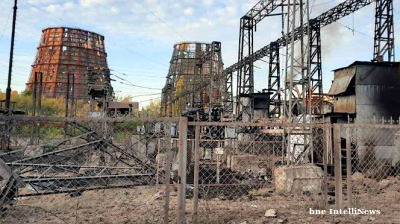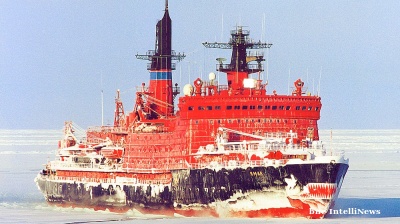The price of gas on the Dutch TTH spot market soared to a new all-time high of over $3,000 per thousand cubic metres on March 7 as energy traders fear the natural gas transit from Russia to Europe and Ukraine’s extensive storage capacity will be caught up in the ongoing war there.
For comparison, at the peak of the gas crisis last year the highest level prices reached was just over $2,000 and normal long-term piped gas prices are closer to $250 per thousand cubic metres.
One of the factors driving up prices is that both the Ukrainian gas pipelines and the country's extensive gas storage could get caught up in the war and be damaged or captured.
The map shows there are about five main strands that run through Ukraine to the west and so far they have been largely unaffected by the fighting and remain in Kyiv-controlled territory.
Ukraine also has the largest gas storage capacity in Europe. When the Soviets got into the gas business, they built almost all of the main storage tanks in Ukraine, which are filled over the course of the summer so that gas can be piped to customers in western Europe over the winter.
Ukraine’s 33.57bn cubic metres of gas storage is just under 80% of all gas storage capacity outside the EU. Ukraine’s storage is also about 21% of all of Europe’s (EU and non-EU) storage capacity.
The EU gas storage capacity is a significant 161 bcm with Germany having the largest individual storage capacity (26 bcm), followed by Italy (20 bcm) and the Netherlands (15 bcm). However, without the Ukrainian super-tanks Europe cannot store enough gas for the winter without switching to alternatives such as LNG and renewables, both of which are still limited in scope to expand their European supplies.
As of March 6 the tanks in the EU are only 27.3% full – their lowest level in four years – but that is still much better than the 12% full they were expected to be at the end of the heating season during the depths of winter last year after starting the heating season with the least gas in storage for the last two decades. That means Europe has got through this winter without running out of gas as some had feared, as the heating season is due to finish at the end of March.
Last year’s gas crisis was caused by an approximately 15 bcm deficit from the roughly 100 bcm that Russia sends to northern Europe each year, so knocking out Ukraine’s storage capacity would already cause a bigger gas crisis than last year even before supply and demand concerns come into play.
Taking out the pipelines and removing an additional 40 bcm from Europe supply plunged Europe into an even bigger gas crisis that would almost certainly mean freezing homes and rolling blackouts through all of next winter.

Ukraine’s own gas production is also in danger. Ukraine has a gas deficit and has to import around 15 bcm of gas a year – now all imported from Ukraine’s partners to the west as it banned imports from Russia about three years ago – but it also has two large gas basins in the east and west and produces about 20 bcm of gas a year, reducing the need to import.
The Dniper-Donets basin contains 1.34 trillion cubic metres of gas and is in the most danger. It runs along the eastern bank of the Dnieper river. For the moment the gas field is just south and east of the Russian occupied territory along the eastern border.
The Lublin basin contains 1.4 to 4.1 tcm of gas and is in Kyiv-controlled territory in the west of the country running south from Lviv to the Moldovan border far from the fighting.
If the war disrupts production in the Dniper-Donets basin that would halve Ukraine’s own production of gas and also plunge the country into its own gas crisis as well as sending the cost of importing gas soaring.
Ukrainian storage tanks lie beside the two gas basins in the east and west, with their total storage capacity roughly divided between the two clusters.
Those in the west scattered around Lviv are in government-controlled areas and in relative safety for now, but the eastern clusters are mostly south of Kharkiv, which is in the epicentre of the current fiercest fighting. These storage tanks are sufficiently far away from the city centre for them not be in any immediate danger of being damaged and well inside government-controlled territory, but several of the tanks are inside the borders of the great Donbas region and one of the scenarios is the Kremlin will capture the entire region and make it into a country. In this case, the new country will need a functioning economy to be able to survive without Kremlin handouts, and having extensive gas storage facilities is an obvious bonus for any economy.
The EU is clearly highly concerned by a possible disruption to gas supplies. British Prime Minister Boris Johnson said in a speech on March 7 that Europe needs to “rapid diversify away from Russian hydrocarbons” and German Chancellor Olaf Scholz has ordered Germany’s first two LNG terminals to be “rapidly” built. But clearly it will take years and billions of euros to reduce Europe’s reliance on gas from the current 40.1% of its energy mix.
Indeed, as bne IntelliNews reported in a feature “V-shaped market” about the causes of last year’s gas crisis, domestic production inside the EU has fallen dramatically in the last few years, so dependence on Russian gas has been increasing. In 2020 the EU imported well over half its energy (57.5%), including 97% of all its oil and 83.6% of gas and 35.8% of its solid fossil fuels, from countries around the world. Russia remains one of the biggest suppliers of those fuels.
The new Green Deal is supposed to solve this problem but the plan has another 28 years to run and the EU is looking at how to head off a huge energy crisis that could begin in only six months time. There is not enough time to make any changes that will have any noticeable effect on energy supplies before this October, when the next heating season starts. Much progress has been made building up renewables, which now account for 22.1% of the mix, but doubling that capacity in six months is not feasible, and Europe would even in that case still need gas to deal with the “base load” problem – providing energy at night and when the wind doesn’t blow.
The Ukrainian route has been falling in importance. It carried 60% of the deliveries to the EU in 2009, but fell to 25% in 2021 after relations with Ukraine sank to rock bottom. Significantly more gas has been arriving in Europe via the new South Stream (or TurkStream) pipeline that came online at the start of 2020 and another 55 bcm of gas deliveries are available via the controversial Nord Stream 2 gas pipeline, which would solve the problem at the turn of a spigot, but the recent round of sanctions has made the idea of turning Nord Stream 2 on impossible.
The EU is currently revising its rules in preparation to build a “strategic gas reserve” facility to store extra gas for times of crisis, but work on this facility has not even passed the concept stage of planning.
LNG is not an option either, as there is simply not enough LNG being produced to replace the Russian supplies of gas. Europe imports a total of just under 200 bcm a year from Russia, if the South Stream deliveries are included with the northern and Ukraine routes, which is the equivalent to a third of global LNG production. Removing that amount from the global market at a stroke would cause an energy crisis in Asia, which is heavily reliant on LNG. Qatar, the world’s biggest producer of LNG, estimates that only 15% of its production could be repurposed to different markets.
And Europe lacks the terminal capacity to take in much more LNG. The total annual import capacity in Europe is 156 bcm of LNG gas equivalent, much of which is already being used, before trying to add another 200 bcm per year of imports to replace Russia’s export of gas to Europe.
Moreover, the biggest LNG terminals are in Spain, but Spain’s connection to the rest of Europe’s pipeline grid is limited, because it relies so heavily on LNG imports and does not tap into the Russian piped gas that fills most of Central Europe’s pipeline network.
The final option to wean the EU off Russian gas is to reduce energy consumption. The Energy Efficiency Directive has a target of reducing energy consumption by 32.5% by 2030, but that is still eight years away and there are no quick fixes that can make a substantial change in the meantime.
There is little talk of banning Russian gas imports, as currently there are no alternatives; imports of Russian gas are simply too important.
There has been talk of banning Russian oil imports and there the situation is slightly better. The international oil market is much more developed and the transport infrastructure more extensive. The share of Russian oil in EU imports is 26.9% according to the EU from 10 other significant suppliers, so cutting off Russian oil is realistic. But as Russian exports are by the same token equally well diversified, this sanction will not have a major impact on Russia’s oil export business. Moreover, imposing sanctions like these will boomerang back and hurt EU producers by causing supply constraints and sending costs of energy soaring.
“The stability of the EU’s energy supply may be threatened if a high proportion of imports are concentrated among relatively few external partners. In 2019, almost two thirds of the extra-EU's crude oil imports came from Russia (27%), Iraq (9%), Nigeria and Saudi Arabia (both 8%) and Kazakhstan and Norway (both 7%). A similar analysis shows that almost three quarters of the EU's imports of natural gas came from Russia (41%), Norway (16%), Algeria (8%) and Qatar (5%), while over three quarters of solid fuel (mostly coal) imports originated from Russia (47%), the United States (18%) and Australia (14%),” the European Commission said on its website discussing the problem and admitting that the EU remains highly dependent on Russia for much of its energy.



Features

Ambition, access and acceleration – Uzbekistan’s Startup Garage opens free academy for entrepreneurship
Aim is to train 50,000 young founders by 2030.

Ukraine’s growing energy crisis promises a cold and dark winter
Since the summer, Kyiv has changed tactics. Given the almost complete failure of Western oil sanctions to curb Russian oil exports, it has been targeting Russian oil refineries. The Kremlin has struck back, targeting Ukraine's power system.

Russia, China sign off on Northern Route shipping deal to slash global freight times
Russia and China have signed a landmark agreement to develop and commercialise the Northern Sea Route (NSR), after Beijing tested the route last month, that could slash Europe-Asia cargo transit times and challenge the primacy of the Suez Canal.

Sri Lanka’s economic escape
Sri Lanka’s recovery over the past year reads like a narrow escape rendered into a cautious, albeit unfinished success story.


